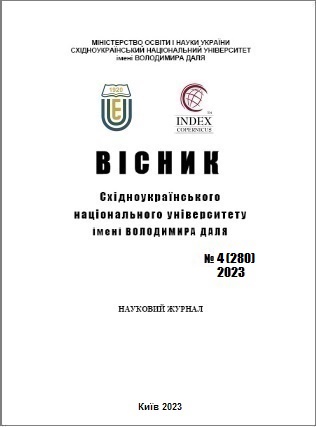Potential for utilization of concrete waste in decontaminated territories: ecological and economic aspects
DOI:
https://doi.org/10.33216/1998-7927-2023-280-4-25-36Keywords:
post-war reconstruction, concrete waste, concrete waste disposal technologies, recycling, concrete waste disposal potential, concrete waste disposal strategy, environmental factors, economic factors, effective concrete disposal strategies, secondary concreteAbstract
The Luhansk region, as a result of active combat, has incurred the most devastated infrastructure, as this area includes settlements with powerful industrial facilities, apartment buildings, social infrastructure, and bridges. Millions of cubic meters of concrete waste generated during such devastation contain various chemical elements and pollutants from explosive substances, such as heavy metals, hydrocarbons, aromatic compounds, nitrates, nitrites, and chlorides.
To expedite pollution neutralization in post-war recovery, society can take measures for the utilization and secondary use of concrete waste to prevent its accumulation in the surrounding environment. The utilization and use of concrete waste in post-war recovery should become a strategic goal aimed at improving waste management, reducing environmental impact, and creating a sustainable construction sector.
The paper demonstrates that potential benefits of secondary use of concrete waste include waste reduction, CO2 emission reduction, increased energy efficiency in the production of primary concrete, and minimization of pollution emissions. In turn, this will contribute to the implementation of circular economy principles, on which post-war recovery should be based, and stimulate the adoption of innovative technologies for processing concrete waste.
Concrete waste utilization can occur through various strategies, such as sorting and recycling, using secondary concrete in constructions, producing secondary concrete with additives, and collaboration with other industries. The paper outlines the drawbacks and advantages of each strategy, providing comparative characteristics of recycling types, offering insights into the appropriateness of each strategy under different conditions.
Effective concrete waste utilization should not only help preserve natural resources and reduce negative environmental impacts but also yield substantial economic benefits. Therefore, the paper identifies criteria for ecological and economic factors that can be used to determine the viability of specific concrete waste utilization strategies.
References
1. Автомонова В. О., Власенко В.В., , К. О. Зайцева К.О., Кривільова С.П. Рециклінг відходів виробництва та брухту бетонних конструкцій як центральна ланка концепції екологізації заводів ЗБК. Вісник Національного технічного університету "ХПІ". Серія : Хімія, хімічна технологія та екологія. 2017. № 48. С. 16-23. URL: https://repository.kpi.kharkov.ua/server/api/core/bi tstreams/0b013ab2-a73c-43fd-bf7f- 85dfef984e19/content (дата звернення 23.11.2023).
2. S.Giorgi, M.Lavagna, A Campioli. Guidelines for effective and sustainable recycling of construction and demolition waste .Designing Sustainable Technologies, Products and Policies (pp.211-221). URL: https://www.researchgate.net/publication/3261508 14_Guidelines_for_Effective_and_Sustainable_Re cycling_of_Construction_and_Demolition_Waste (дата звернення 23.11.2023)
3. How is Sustainable Concrete Made? A Guide For Architects, Designers, and Builders. Website: UGREENURL: https://ugreen.io/how-issustainable- concrete-made-a-guide-for-architectsdesigners- and-builders/ (дата звернення 23.11.2023)
4. M. Machaka, A. Elkordi , J. M. Khatib. Handbook of Sustainable Concrete and Industrial Waste Management Recycled and Artificial Aggregate, Innovative Eco-friendly Binders, and Life Cycle Assessment, Beirut Arab University University of Wolve, 2021 part 1 - Natural fibers URL: https://www.researchgate.net/publication/3569071 28_Handbook_of_Sustainable_Concrete_and_Indu strial_Waste_Management_Recycled_and_Artifici al_Aggregate_Innovative_Ecofriendly_ Binders_and_Life_Cycle_Assessment_1s t_Edition_-_December_1_2021_part_1_- _Natu (дата звернення 23.11.2023)
5. Dongxing Xuana, Chi Sun Poon a, Wei Zhengb Management and sustainable utilization of processing wastes from ready-mixed concrete plants in construction: Resources, Conservation and RecyclingVo.136, September 2018, Pages 238-247 URL: https://www.sciencedirect.com/science/article/abs/ pii/S0921344918301393 (дата звернення 23.11.2023)
6. Abraham T. Gebremariam, Francesco Di Maio, Ali Vahidi, Peter Rem. Innovative technologies for recycling End-of-Life concrete waste in the built environment Resources, Conservation and Recycling Vo. 163, December 2020, 104911 URL: https://www.sciencedirect.com/science/article/pii/S 0921344920302299(дата звернення 23.11.2023)
7. Смаль М.В., Дзюбинська О.В., Шелкович О Світовий досвід повторного використання бетону в будівельному виробництві Сучасні технології та методи розрахунків у будівництві. 2017. вип. 7. С 233-238.
8. Арутюнян А.І., Шуваєв А.А. Екологічно- економічна доцільність комплексного управління потоками відходів в будівельній галузі. Мости та тунелі: теорія, дослідження практика. 2020. № 18. C. 9-17. URL: https://doi.org/10.15802/bttrp2020/217692 (дата звернення 23.11.2023)
9. Лялюк О.Г., О.Г.Ратушняк О.Г., Лялюк А.О. Екологічний менеджмент відходів будівельного виробництва. Сучасні технології, матеріали і конструкції в будівництві. 2017. № 1. С. 94-100. URL: (Microsoft Word - 306363360355340353 2017-1) (vntu.edu.ua) (дата звернення 23.11.2023).
10. Ситуація на Луганщині - скільки будинків зруйновано в Луганській області - наслідки російської агресії на Луганщині - веб-сайт: Парламент.UA. URL: https://parlament.ua/news/gajdaj-nazvav-kilkistzrujnovanih- okupantami-budinkiv-naluganshhini/ ( дата звернення 23.11.2023)
11. ДСТУ Б В.2.6-64:2008. Технічні норми, правила і стандарти. Об’єкти будівництва та промислова продукція будівельного призначення. Конструкції будинків і споруд. Панелі стінові зовнішні бетонні і залізобетонні для житлових і громадських будинків. К.: Мінрегіонбуд України, 2009. 37 с..
12. Чалая О. С., Фатєєва Н.Ю. Вплив важких металів на організм людини. Вісник Харківського національного технічного університету сільського господарства імені Петра Василенка. - 2018. - Вип. 190. С. 110-116. URL: http://nbuv.gov.ua/UJRN/Vkhdtusg_2018_190_19. (дата звернення 23.11.2023)
13. Сплодитель, А., Голубцов, О., Чумаченко, С., & Сорокіна, Л. Забруднення земель внаслідок агресії Росії проти України. Київ: ГО “Центр екологічних ініціатив «Екодія», 2023 URL: https://ecoaction.org.ua/wpcontent/ uploads/2023/03/zabrudnennia-zemel-vidrosii. Pdf (дата звернення 23.11.2023)
14. Рихліцька О. В. Бетони з підвищеними експлуатаційними властивостями на основі заповнювачів рециклінгу бетону: дис. докт. філ: 192 Будівництво та цивільна інженерія. Львів, 2023. 176с. URL:__https://lpnu.ua/sites/default/files/2023/radaphd/23182/disertaciya-rikhlicka-ov.pdf (дата звернення 23.11.2023)
15. Хрутьба, В. О., Вайганг, Г. О., Крюковська, Л. І.І. Визначення показників екологічної безпеки проектів використання відходів як дорожньо- будівельного матеріалу. Технологічний аудит і резерви виробництва. 2015. 4(4), С.64-71.
16. Chen, Y., Vandecasteele, C., Shen, D., & Xuan, X. Municipal solid waste incineration residues recycled for typical construction materials—a review. RSC Advances, 2019No 10 95, C.6279- 6291. DOI link: https://doi.org/10.1039/D1RA08050D
17. Dodoo A, Gustavsson L and Asthre, R. Carbon Implications of End-of-life Management of Building Materials. Resources, Conservation and Recycling. 2009. 53: 276-286.
18. Etxeberria M, Vázquez E, Marí, A and Barra M. Influence of amount of recycled coarse aggregates and production process on properties of recycled aggregate concrete. Cement and Concrete Research. 37: 2007. 735-742.
19. Brown, A., & Green, C. "Economic Impact of Concrete Waste Utilization in Construction." Journal of Sustainable Development, 2018. 15(2), 75-88.
20. Vivian W.Y. Tam Economic comparison of concrete recycling: A case study approach l Resources, Conservation and RecyclingVolume 52, Issue 5, March 2008, Р. 821-828 URL:https://www.sciencedirect.com/science/articl e/abs/pii/S0921344907002248 (дата звернення 23.11.2023)

